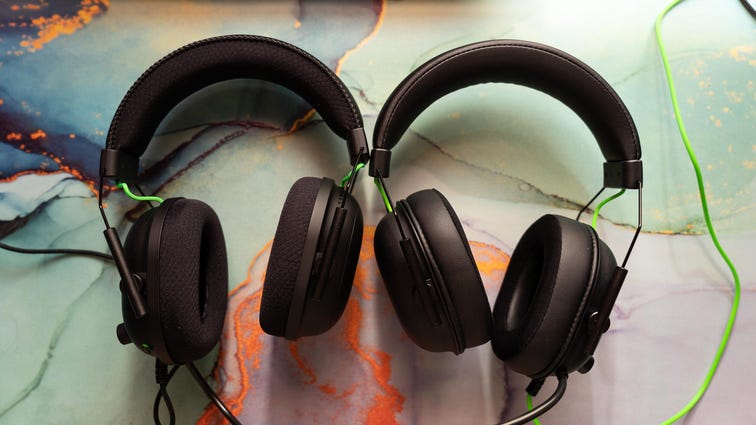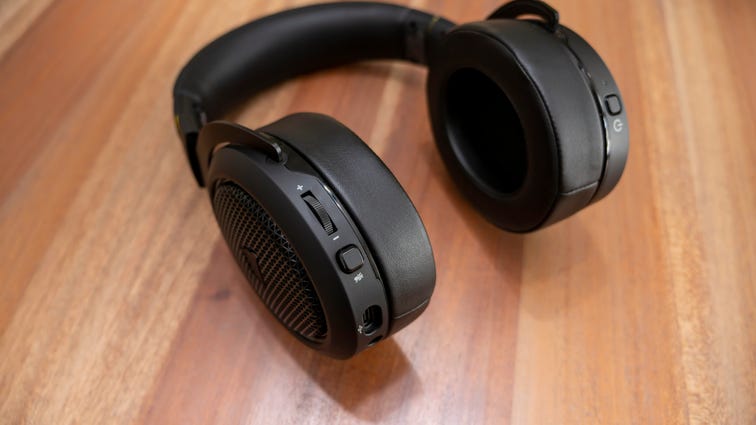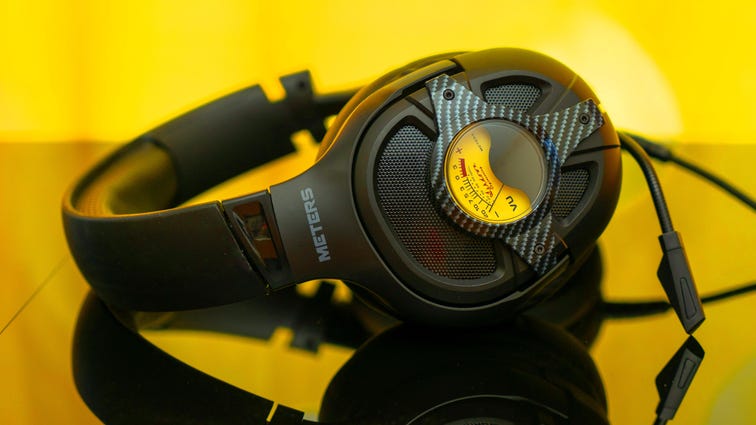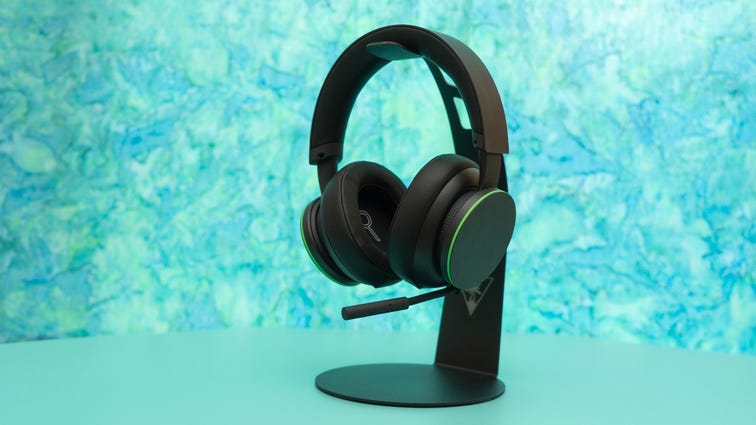The days are getting darker and chillier, which means you’ll probably be gaming more than ever — so you might want to consider upgrading your audio. After all, it’s hard to find a graphics card to spend your money on right now and you’re already spending more time on video calls, so treating yourself to a new PC gaming headset is a way to satisfy your work brain and your play brain without blowing a ton of money.
A PC gaming headset offers much more than great sound. A good pair is also a great way to improve your stats by blocking out background noise, allowing you to better communicate with your gamer friends. But there are a lot of PC gaming headsets to choose from. To help narrow down the options, here are our tried-and-true picks.
Read more: The best Xbox gaming headset for 2022
Keep in mind that analog gaming headphones with 3.5mm jacks can work on almost any device — PS5, Xbox Series X or S, Nintendo Switch and so on — in addition to Windows PCs. But you may not get the full set of features on other devices, such as surround sound, mic monitoring/sidetone and other usually software-driven capabilities. I’ve used all of these PC headset options with both the PC and Xbox.
Also, if you’re a gamer looking beyond excellent audio quality and want to update other aspects of your gaming rig, be sure to check out our picks for best gaming mice, gaming keyboards, gaming laptops and other gaming essentials, like a gaming router or a fast VPN.
Read more: The best VR games for escaping to other worlds

 \n ","topic":"","ttag":"","variant":"","viewguid":"","event":"listicle|image|1","correlationId":"","_destCat":"https:\/\/www.amazon.com\/SteelSeries-Arctis-Wireless-Gaming-Headset-Integrated\/dp\/B07RJHH6Q8\/","productName":"SteelSeries Arctis 9X","formatType":"IMAGE","location":"LIST","position":1,"sku":"61483","dwLinkTag":"article-body|listicle|image","selector":"#article-body #listicle-9b6f245c-2285-4abd-a554-4735a8e1c43f .itemImage"}}” rel=”noopener nofollow” target=”_blank”>
\n ","topic":"","ttag":"","variant":"","viewguid":"","event":"listicle|image|1","correlationId":"","_destCat":"https:\/\/www.amazon.com\/SteelSeries-Arctis-Wireless-Gaming-Headset-Integrated\/dp\/B07RJHH6Q8\/","productName":"SteelSeries Arctis 9X","formatType":"IMAGE","location":"LIST","position":1,"sku":"61483","dwLinkTag":"article-body|listicle|image","selector":"#article-body #listicle-9b6f245c-2285-4abd-a554-4735a8e1c43f .itemImage"}}” rel=”noopener nofollow” target=”_blank”>


Lori Grunin/CNET
This excellent wireless headset supports both Bluetooth and 2.4GHz connections for simultaneous lag-free gaming and audio monitoring, with a bunch of excellent perks. These include the ability to use it wired or while it charges over USB, a Discord-certified noise-canceling retractable microphone, swivel ear cups to let it sit on your shoulders, and support for DTS Headphone:X v2.0 and Windows Spatial audio. Its pucklike dongle has an analog 3.5mm input for game audio and a line out to the headset, which expands its usefulness. My only significant quibble with the Arctis 9X is it feels a little too tight on my head (which is odd, since all the other Arctis models feel fine). Its big brother, the SteelSeries Arctis Pro Wireless, garners rave reviews as well, but it’s significantly more expensive as well as relatively old; it’s due for an upgrade and I think it’s a bit overkill for many gamers, anyway.

 \n ","topic":"","ttag":"","variant":"","viewguid":"","event":"listicle|image|2","correlationId":"","_destCat":"https:\/\/www.bestbuy.com\/site\/razer-blackshark-v2-wired-thx-spatial-audio-gaming-headset-for-pc-ps4-ps5-switch-xbox-one-series-xs-black\/6417115.p?skuId=6417115","productName":"Razer Blackshark V2 X","formatType":"IMAGE","location":"LIST","position":2,"sku":"RZ04-03240100-R3U1","dwLinkTag":"article-body|listicle|image","selector":"#article-body #listicle-fcdb71fd-7ac7-492e-8fc9-4180b514f298 .itemImage"}}” rel=”noopener nofollow” target=”_blank”>
\n ","topic":"","ttag":"","variant":"","viewguid":"","event":"listicle|image|2","correlationId":"","_destCat":"https:\/\/www.bestbuy.com\/site\/razer-blackshark-v2-wired-thx-spatial-audio-gaming-headset-for-pc-ps4-ps5-switch-xbox-one-series-xs-black\/6417115.p?skuId=6417115","productName":"Razer Blackshark V2 X","formatType":"IMAGE","location":"LIST","position":2,"sku":"RZ04-03240100-R3U1","dwLinkTag":"article-body|listicle|image","selector":"#article-body #listicle-fcdb71fd-7ac7-492e-8fc9-4180b514f298 .itemImage"}}” rel=”noopener nofollow” target=”_blank”>


Lori Grunin/CNET
These aren’t the absolute best in gaming headsets, but the newest generation of Razer’s BlackShark headsets — the wired Razer BlackShark V2 ($100) and V2 X ($60) and the Wireless V2 Pro ($180) — offer well-rounded option if you need a single headset for both work and play. I prefer the V2 over the V2 X for its extra PC features, like support for THX Spatial Audio, microphone settings in Razer’s Synapse utility and a USB dongle. Plus, it has a better cord, removable mic with foam cover and breathable fabric on the ear cup padding. If you’re on a tighter budget, the analog-only V2 X has all your platforms covered for a little half the price.

 \n ","topic":"","ttag":"","variant":"","viewguid":"","event":"listicle|image|3","correlationId":"","_destCat":"https:\/\/www.bestbuy.com\/site\/rig-500-pro-hx-xbox-gaming-headset-with-3d-audio-black\/6454685.p?skuId=6454685","productName":"","formatType":"IMAGE","location":"LIST","position":3,"sku":"","dwLinkTag":"article-body|listicle|image","selector":"#article-body #listicle-02d940c8-cd3b-4853-a4d8-3bef55a3911a .itemImage"}}” rel=”noopener nofollow” target=”_blank”>
\n ","topic":"","ttag":"","variant":"","viewguid":"","event":"listicle|image|3","correlationId":"","_destCat":"https:\/\/www.bestbuy.com\/site\/rig-500-pro-hx-xbox-gaming-headset-with-3d-audio-black\/6454685.p?skuId=6454685","productName":"","formatType":"IMAGE","location":"LIST","position":3,"sku":"","dwLinkTag":"article-body|listicle|image","selector":"#article-body #listicle-02d940c8-cd3b-4853-a4d8-3bef55a3911a .itemImage"}}” rel=”noopener nofollow” target=”_blank”>


Lori Grunin/CNET
The first time I saw the Rig series of gaming headsets — well before the brand was bought by gaming and accessory company Nacon — I was so turned off by the aesthetic I didn’t even take the headset out of the box. I powered through this time, and although I’m still not fond of the appearance, it’s turned out to be one of my go-to headsets in why-doesn’t-my-pc-see-my-wireless-headset emergencies.
You get a lot for the money. It’s comfortable and relatively light with good 3D audio, pretty decent mic quality, good noise isolation and an inline volume control that’s neither too far down the cable or too far up. The mic is both removable and flip-up, which you rarely see at this price.
The last generation of the headset got complaints about build quality, but I’ve been using it for months with no issues. Its flat rubber cable is a step up from competitors: Flatness makes it tangle-free and less susceptible to damage when I roll over it with my chair. To adjust size, there’s a combination of three notches on the headband — you basically pop out the earcup to move it, so if it comes under stress it just pops out — and a basic suspension band.
It doesn’t come with a headphone/mic splitter cable, a common omission in budget headsets, and the short-ish cable’s not removable, but it’s a good length if you’re going to plug it into a controller for use with the Xbox. But you do get a an activation card for a Dolby Atmos subscription (mine was for a year but it’s possible that period’s been cut back in the interim) for Windows 10 and Xbox One or later.

 \n ","topic":"","ttag":"","variant":"","viewguid":"","event":"listicle|image|4","correlationId":"","_destCat":"https:\/\/www.bestbuy.com\/site\/hyperx-cloud-ii-wireless-7-1-surround-sound-gaming-headset-for-pc-and-playstation-black-red\/6447772.p?skuId=6447772","productName":"HyperX Cloud II – headset","formatType":"IMAGE","location":"LIST","position":4,"sku":"HHSC2X-BA-RD\/G","dwLinkTag":"article-body|listicle|image","selector":"#article-body #listicle-c9bcc865-2d53-44d9-bd65-2aeec02d39e0 .itemImage"}}” rel=”noopener nofollow” target=”_blank”>
\n ","topic":"","ttag":"","variant":"","viewguid":"","event":"listicle|image|4","correlationId":"","_destCat":"https:\/\/www.bestbuy.com\/site\/hyperx-cloud-ii-wireless-7-1-surround-sound-gaming-headset-for-pc-and-playstation-black-red\/6447772.p?skuId=6447772","productName":"HyperX Cloud II – headset","formatType":"IMAGE","location":"LIST","position":4,"sku":"HHSC2X-BA-RD\/G","dwLinkTag":"article-body|listicle|image","selector":"#article-body #listicle-c9bcc865-2d53-44d9-bd65-2aeec02d39e0 .itemImage"}}” rel=”noopener nofollow” target=”_blank”>


Lori Grunin/CNET
It’s priced on the high side for a virtual 7.1 surround headset lacking in many features, but what the lightweight HyperX Cloud II Wireless is missing in capabilities it makes up for in comfort and performance, such as a 60-foot signal range and good battery life. You can use it wirelessly with a PS4/PS5 and Nintendo Switch as well as a PC.

 \n ","topic":"","ttag":"","variant":"","viewguid":"","event":"listicle|image|5","correlationId":"","_destCat":"https:\/\/www.bestbuy.com\/site\/corsair-hs70-wired-stereo-gaming-headset-with-bluetooth-for-pc-switch-ps5-ps4-xbox-series-xs-xbox-one-discord-certified-black\/6431056.p","productName":"CORSAIR Gaming HS70 – headset","formatType":"IMAGE","location":"LIST","position":5,"sku":"CA-9011227-NA","dwLinkTag":"article-body|listicle|image","selector":"#article-body #listicle-58dc78e6-c1b1-4b69-a813-3206c71c7a21 .itemImage"}}” rel=”noopener nofollow” target=”_blank”>
\n ","topic":"","ttag":"","variant":"","viewguid":"","event":"listicle|image|5","correlationId":"","_destCat":"https:\/\/www.bestbuy.com\/site\/corsair-hs70-wired-stereo-gaming-headset-with-bluetooth-for-pc-switch-ps5-ps4-xbox-series-xs-xbox-one-discord-certified-black\/6431056.p","productName":"CORSAIR Gaming HS70 – headset","formatType":"IMAGE","location":"LIST","position":5,"sku":"CA-9011227-NA","dwLinkTag":"article-body|listicle|image","selector":"#article-body #listicle-58dc78e6-c1b1-4b69-a813-3206c71c7a21 .itemImage"}}” rel=”noopener nofollow” target=”_blank”>


Josh Goldman/CNET
The ability to monitor your phone (or other audio) via Bluetooth with your headset while simultaneously using a separate, lag-free connection for gaming is a useful capability, but that frequently adds a premium onto the price. By adding Bluetooth to an otherwise wired headset — usually it’s only available in wireless models — Corsair manages to avoid that trap. The stereo HS70 supports USB for laptops and desktops, along with 3.5mm analog cabling to connect to all consoles. The battery is rated for about 30 hours, and the noise-canceling microphone is detachable. The company’s iCue app for Windows or MacOS to access EQ presets or adjust mic and sidetone levels. Though it’s not as pricey as most gaming headsets with Bluetooth on the side, it is relatively expensive for an otherwise basic model. And oddly, the HS70 Wireless, which lacks Bluetooth but incorporates a 2.4GHz connection, is the same price.

 \n ","topic":"","ttag":"","variant":"","viewguid":"","event":"listicle|image|6","correlationId":"","_destCat":"https:\/\/www.eposaudio.com\/en\/us\/gaming\/products\/h3pro-hybrid-sebring-bluetooth-low-latency-connection-gaming-headset-1000892","productName":"","formatType":"IMAGE","location":"LIST","position":6,"sku":"","dwLinkTag":"article-body|listicle|image","selector":"#article-body #listicle-97b96045-1088-4015-9e65-30597c2c198d .itemImage"}}” rel=”noopener nofollow” target=”_blank”>
\n ","topic":"","ttag":"","variant":"","viewguid":"","event":"listicle|image|6","correlationId":"","_destCat":"https:\/\/www.eposaudio.com\/en\/us\/gaming\/products\/h3pro-hybrid-sebring-bluetooth-low-latency-connection-gaming-headset-1000892","productName":"","formatType":"IMAGE","location":"LIST","position":6,"sku":"","dwLinkTag":"article-body|listicle|image","selector":"#article-body #listicle-97b96045-1088-4015-9e65-30597c2c198d .itemImage"}}” rel=”noopener nofollow” target=”_blank”>


Lori Grunin/CNET
This may be a somewhat controversial choice overall, but even a lot of people who don’t like the Epos gaming headsets in general tend to agree that they have great stereo audiophile-quality sound. Given Epos’ kinship with audio veteran Sennheiser — and unfortunately, the Sennheiser-level high prices — one expects no less.
I really like the H3Pro Hybrid, though, for gamers who don’t need surround sound. They have rudimentary support via software (or an extra-cost external sound card), but lack a lot of the capabilities of most true 7.1 headsets such as Dolby Surround or DTS Headphone:X compatibility, which you’d expect for the price, instead using proprietary surround technology. That, plus only passable signal retention via the dongle — it occasionally gives me problems starting at about 16 feet away, roughly a half (or more) the distance of other headsets, but doesn’t seem to have any lag while gaming — are the only two issues I have with it. But they’re not minor issues, so may be deal killers for a lot of people. The software’s kind of lackluster as well.
But they have a really broad set of functional features. Those include the same connect-to-everything flexiblity of the Arctis 9X: You can’t use two Bluetooth connections simultaneously, but any other wired and/or wireless pairing works. Unlike so many other headsets I’ve tried, you don’t need to constantly replug the dongle, and when they disconnect or go into standby mode they reconnect promptly.
The novel design has two mics, a flip-to-mute magnetized detachable boom mic plus a mic built into one of the earcups to use without the boom, and the boom performs very well once you get it positioned; the earcup mic also helps with noise suppression for the boom.
There’s also a small mic in the earcup to enhance the noise cancellation, and its active noise cancellation works quite well; the earcups filter out a ton of noise even without the ANC (though they’re leatherette-covered memory foam, which can make for some sweaty ears.
They’re really comfortable for extended wear and on the lighter side given everything inside them (10-11 ounces/288-309g depending on whether the boom’s attached) at least for my head and with glasses on, plus the battery lasts a relatively long time and doesn’t run down quickly when they’re not used for a while. And they’re far less bulky and aesthetically gamey than many competitors.
There are cheaper models in this line, the $99 wired H3 and $179 wireless Bluetooth-only H3 Hybrid

 \n ","topic":"","ttag":"","variant":"","viewguid":"","event":"listicle|image|7","correlationId":"","_destCat":"https:\/\/www.amazon.com\/Meters-Level-Up-Surround-Gaming-Headset\/dp\/B08JQF6611\/","productName":"","formatType":"IMAGE","location":"LIST","position":7,"sku":"","dwLinkTag":"article-body|listicle|image","selector":"#article-body #listicle-a7941862-7902-48f5-9fb2-de4a8bd8854c .itemImage"}}” rel=”noopener nofollow” target=”_blank”>
\n ","topic":"","ttag":"","variant":"","viewguid":"","event":"listicle|image|7","correlationId":"","_destCat":"https:\/\/www.amazon.com\/Meters-Level-Up-Surround-Gaming-Headset\/dp\/B08JQF6611\/","productName":"","formatType":"IMAGE","location":"LIST","position":7,"sku":"","dwLinkTag":"article-body|listicle|image","selector":"#article-body #listicle-a7941862-7902-48f5-9fb2-de4a8bd8854c .itemImage"}}” rel=”noopener nofollow” target=”_blank”>


Lori Grunin/CNET
The Level Up’s comfy, retro-ish style — with on-ear cup illuminated VU meters, full-bodied stereo and 7.1 virtual surround sound for music and gaming — lead me to recommend it for people who aren’t necessarily looking for cutting-edge gaming features, but who want something cool and different. You can use it with any 3.5mm-jack-bearing console or system, but you don’t get the customizable surround setup unless you’re connected via USB on Windows, since it requires a proprietary app.

 \n ","topic":"","ttag":"","variant":"","viewguid":"","event":"listicle|image|8","correlationId":"","_destCat":"https:\/\/www.amazon.com\/Logitech-Wireless-Headset-Black-Tico\/dp\/B081415GCS\/","productName":"Logitech G733 LIGHTSPEED Wireless RGB Gaming Headset – headset","formatType":"IMAGE","location":"LIST","position":8,"sku":"981-000863","dwLinkTag":"article-body|listicle|image","selector":"#article-body #listicle-24880c0f-7b19-4840-8d9d-4ae8dfc6ff55 .itemImage"}}” rel=”noopener nofollow” target=”_blank”>
\n ","topic":"","ttag":"","variant":"","viewguid":"","event":"listicle|image|8","correlationId":"","_destCat":"https:\/\/www.amazon.com\/Logitech-Wireless-Headset-Black-Tico\/dp\/B081415GCS\/","productName":"Logitech G733 LIGHTSPEED Wireless RGB Gaming Headset – headset","formatType":"IMAGE","location":"LIST","position":8,"sku":"981-000863","dwLinkTag":"article-body|listicle|image","selector":"#article-body #listicle-24880c0f-7b19-4840-8d9d-4ae8dfc6ff55 .itemImage"}}” rel=”noopener nofollow” target=”_blank”>


The G733’s generally an above average lightweight wireless gaming headset, but it’s got one advantage over much of the competition: an excellent mic backed by an insane level of customizability via Blue Yeti-powered software.

 \n ","topic":"","ttag":"","variant":"","viewguid":"","event":"listicle|image|9","correlationId":"","_destCat":"https:\/\/www.walmart.com\/ip\/Microsoft-Xbox-Wireless-Headset-for-Xbox-Series-X-S-Xbox-One-and-Windows-10-Devices\/466809446?wmlspartner=wlpa&selectedSellerId=0&wl13=3488&adid=22222222277466809446_117755028669_12420145346&wmlspartner=wmtlabs&wl0=&wl1=g&wl2=c&wl3=501107745824&wl4=pla-293946777986&wl5=9018827&wl6=&wl7=&wl8=&wl9=pla&wl10=8175035&wl11=local&wl12=466809446&wl13=3488&veh=sem_LIA&gclid=Cj0KCQiAr5iQBhCsARIsAPcwROOzGxZX36_idk6z8bD0atCPUkn6w9GEHPiSP2KqdC13oEtW6fYeNp4aAiAYEALw_wcB&gclsrc=aw.ds","productName":"Microsoft Xbox Wireless Headset – headset","formatType":"IMAGE","location":"LIST","position":9,"sku":"TLL-00001","dwLinkTag":"article-body|listicle|image","selector":"#article-body #listicle-80ced636-b2c1-4b10-9bf7-d34426e5824f .itemImage"}}” rel=”noopener nofollow” target=”_blank”>
\n ","topic":"","ttag":"","variant":"","viewguid":"","event":"listicle|image|9","correlationId":"","_destCat":"https:\/\/www.walmart.com\/ip\/Microsoft-Xbox-Wireless-Headset-for-Xbox-Series-X-S-Xbox-One-and-Windows-10-Devices\/466809446?wmlspartner=wlpa&selectedSellerId=0&wl13=3488&adid=22222222277466809446_117755028669_12420145346&wmlspartner=wmtlabs&wl0=&wl1=g&wl2=c&wl3=501107745824&wl4=pla-293946777986&wl5=9018827&wl6=&wl7=&wl8=&wl9=pla&wl10=8175035&wl11=local&wl12=466809446&wl13=3488&veh=sem_LIA&gclid=Cj0KCQiAr5iQBhCsARIsAPcwROOzGxZX36_idk6z8bD0atCPUkn6w9GEHPiSP2KqdC13oEtW6fYeNp4aAiAYEALw_wcB&gclsrc=aw.ds","productName":"Microsoft Xbox Wireless Headset – headset","formatType":"IMAGE","location":"LIST","position":9,"sku":"TLL-00001","dwLinkTag":"article-body|listicle|image","selector":"#article-body #listicle-80ced636-b2c1-4b10-9bf7-d34426e5824f .itemImage"}}” rel=”noopener nofollow” target=”_blank”>


Lori Grunin/CNET
Even though it has some design and feature quirks, for $89, the Xbox Wireless Headset is a good deal. Simultaneous wireless and Bluetooth and chat-mix balance are usually only found in more expensive models, so here the performance and sound quality are worth the money.

 \n ","topic":"","ttag":"","variant":"","viewguid":"","event":"listicle|image|10","correlationId":"","_destCat":"https:\/\/steelseries.com\/gaming-headsets\/arctis-7x","productName":"SteelSeries Arctis 7x – headset","formatType":"IMAGE","location":"LIST","position":10,"sku":"61466","dwLinkTag":"article-body|listicle|image","selector":"#article-body #listicle-fe19d094-a2bb-490d-9150-66638c7186b2 .itemImage"}}” rel=”noopener nofollow” target=”_blank”>
\n ","topic":"","ttag":"","variant":"","viewguid":"","event":"listicle|image|10","correlationId":"","_destCat":"https:\/\/steelseries.com\/gaming-headsets\/arctis-7x","productName":"SteelSeries Arctis 7x – headset","formatType":"IMAGE","location":"LIST","position":10,"sku":"61466","dwLinkTag":"article-body|listicle|image","selector":"#article-body #listicle-fe19d094-a2bb-490d-9150-66638c7186b2 .itemImage"}}” rel=”noopener nofollow” target=”_blank”>


Lori Grunin/CNET
Though it’s part of the Designed for Xbox program, the 7X also works wirelessly at 2.4GHz with the PC, Nintendo Switch and PlayStation (through PS5) rather than resorting to an analog wired connection for those secondary platforms. It has the great audio and design of the more-expensive 9X, but feels a tad more comfortable.
SteelSeries also recently launched the Arctis 7P Plus (for PC and PlayStation) to replace the 7P, and that’s up next in my headset testing queue.
Read more:

